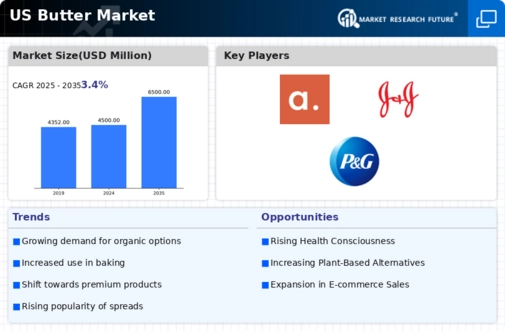Diverse Product Offerings
The butter market is experiencing a diversification of product offerings, which appears to be a significant driver of growth. Manufacturers are introducing a variety of butter types, including flavored, whipped, and reduced-fat options, catering to a broader range of consumer preferences. This trend is supported by market data indicating that flavored butter sales have increased by 15% in the past year alone. The introduction of innovative products allows consumers to explore new culinary experiences while meeting their dietary needs. As the market continues to evolve, the expansion of product lines may attract new customers and enhance overall market growth.
Rising Health Consciousness
The increasing awareness of health and nutrition among consumers appears to be a pivotal driver in the butter market. As individuals seek to incorporate healthier fats into their diets, the demand for butter, particularly varieties that are perceived as natural and less processed, is likely to rise. This trend is reflected in the market data, which indicates that sales of butter have grown by approximately 5% annually over the past few years. Consumers are gravitating towards products that offer nutritional benefits, such as those rich in vitamins A and D. This shift in consumer behavior suggests that the butter market is adapting to meet the needs of a more health-conscious demographic, potentially leading to increased product innovation and diversification.
Impact of Food Service Industry
The food service industry plays a crucial role in shaping the butter market, as restaurants and cafes increasingly incorporate butter into their menus. The demand for high-quality butter in food preparation and as a finishing ingredient is on the rise, driven by consumer preferences for rich flavors and authentic culinary experiences. Recent data indicates that butter usage in the food service sector has grown by approximately 8% over the last year. This trend suggests that as dining out becomes more popular, the butter market may see a corresponding increase in demand, particularly for premium and artisanal butter products.
Sustainability and Ethical Sourcing
Sustainability concerns are becoming increasingly relevant in the butter market, as consumers demand transparency regarding the sourcing and production of their food. The emphasis on ethical farming practices and environmentally friendly production methods is influencing purchasing decisions. Data suggests that approximately 30% of consumers are willing to pay a premium for butter products that are certified organic or sourced from sustainable farms. This trend indicates a shift towards more responsible consumption, which could reshape the butter market landscape. As producers respond to these demands, the market may see a rise in the availability of sustainably sourced butter, appealing to environmentally conscious consumers.
Culinary Trends and Cooking Practices
The evolving culinary landscape in the United States significantly influences the butter market. As cooking at home becomes more popular, consumers are increasingly experimenting with traditional recipes that utilize butter as a key ingredient. This trend is supported by data showing that butter usage in home cooking has surged, with a reported increase of 10% in household purchases over the last year. Additionally, the rise of gourmet cooking and baking shows has inspired consumers to seek high-quality butter products, further driving demand. The butter market is likely to benefit from this trend, as consumers prioritize flavor and quality in their culinary endeavors, leading to a potential increase in premium butter sales.














Leave a Comment